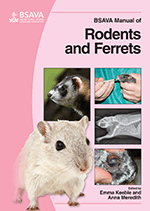
Full text loading...

The anatomy and physiology of the eyeball (bulbus oculi) is fairly uniform amongst rodent species, but they do show some interesting structural differences regarding the bony orbital anatomy. Three elements constitute the zygomatic arch in rodents: (i) the zygomatic bone; (ii) the zygomatic process of the maxillary bone; and (iii) the zygomatic process of the temporal bone. The presence of a prominent and well developed zygomatic process of the maxillary bone is what differentiates the zygomatic arch of rodents from that of dogs and cats. The chapter covers Basic ocular anatomical features of rodents; Physical restraint and ophthalmic examination; Ophthalmological diseases such as disorders of the eyelids and periocular infections, conjunctivitis and other conjunctival diseases, corneal diseases and diseases of the lens.
Rodents: ophthalmology, Page 1 of 1
< Previous page | Next page > /docserver/preview/fulltext/10.22233/9781905319565/9781905319565.15-1.gif

Full text loading...











